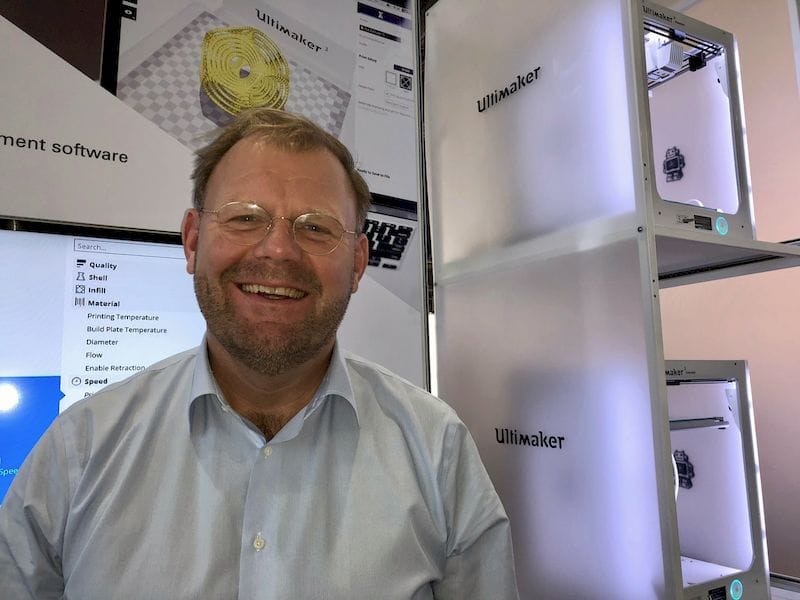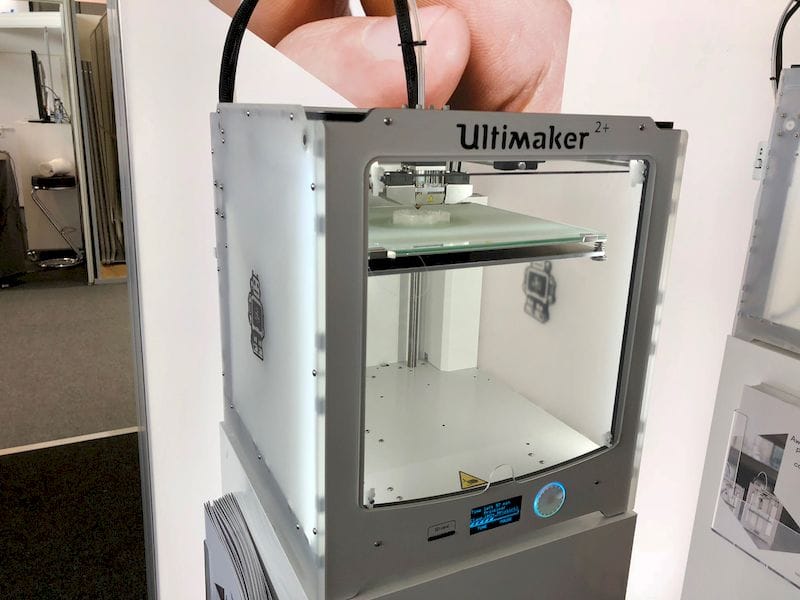
At Formnext, we had a very interesting – and fun – discussion with Ultimaker’s SVP of Product Management, Paul Heiden.
We reviewed aspects of Ultimaker’s strategy that I had never heard from representatives of the company, but after the chat, things are quite clear.
This is part 2 of a 2 part interview. Part 1 is here.
Fabbaloo: That must mean there’s been more flood gates open for sales? You must be selling a lot of these things now? I got that suspicion when I saw the big investment coming through; something’s going on there. Somebody believes that there’s a lot of money to be made. So you must be selling a lot now, or on the verge of doing so?
Paul Heiden: Of course we are extremely happy with that. It’s both an acquisition and an investment of course. We really feel that we are entering the next mountain. I think we came out pretty much top of 3D printing of industrial 3D printing; us and Formlabs, we are the two left standing. We need to be equipped with a lot of money to for the next round. That’s the main reason why we felt the urgency to do this.
Fabbaloo: We wrote a little story about that investment, and I’m not sure you read it. When I wrote it, I wondered “What is Ultimaker going to think about this?” What do you think of what we said?
Paul Heiden: It was pretty much the point.
Fabbaloo: Other publications may suggest Ultimaker is going to the “dark side” instead of “open source”. But it is serious business going on and you have to fit into that scenario, because that’s the size you’re at, and that’s where you have to go.
Paul Heiden: Particularly with my background I’m not very religious about open source, but I do see that it works tremendously well for adopting 3D printing. I mean it’s just textbook, what Cura did. There aren’t many better examples.
Nowadays I should be making that choice for each piece of software whether it will help to put it open source or just to keep it a little bit close because we don’t want people to copy it. Cura Connect is much closer with the connectivity with Solidworks. We’re not too sure we’re doing that entirely right. So we said let’s make it open and let everybody come to find out.
Fabbaloo: The Ultimaker 3 is it open or closed?
Paul Heiden: Totally open. October 18th we released the STEP files.

Fabbaloo: Years ago when MakerBot was releasing open source files they found the the Asian companies were instantly making copies. There’s been a bit of that with Ultimaker, too. Are you finding that with the Ultimaker 3? Or does that even matter at this point?
Paul Heiden: Months ago we appointed our distributor in China and that was the last white space we have in our worldwide map. And the reason we postponed this time and time again had everything to do with copying. But now we feel that the combination of software, hardware and material knowledge and also the whole ecosystem makes it a reliable printer. If you just copy the hardware, the chances that you actually print right it’s about 50 percent. Whereas if you use Cura software you use printing profiles for right material. Then the liability gets to 95% which for our users is a necessity. We feel that makes it defensible even in China.
Fabbaloo: So it’s “go ahead, try it, it won’t work anyway”?
Paul Heiden: It’s a little bit like our attitude and it’s only getting more attached to each other. Now we are working with these chemical firms and we literally say if you bring materials to market, we will help you with building the right print profile because it’s in our interest that people use the Dupont materials reliably.
Fabbaloo: Which chemical companies are you working with?
Paul Heiden: Dupont, Eastman, Sabic, BASF.
Fabbaloo: Had to be BASF because they’re apparently involved with everyone!
Paul Heiden: They all started their additive manufacturing business units. Filaments, resins and powders are brought together and for us it’s great. We can work with these folks. I’m sure that whatever they bring to market our software supports.
Fabbaloo: At this stage Ultimaker has a solid machine with sets of materials they can be run on it. But as I walk around the show floor I see many other machines that are higher temperature, they’re bigger. Or there’s some other angle that makes it different and someone could say “maybe better than Ultimaker” because of some specification. How do you deal with that?
Paul Heiden: One of course is that there is the whole system; it’s not just the hardware it’s in the software. Cura is coming now close to two million users. We learn a lot from them. We have the material profiles. The whole system helps us getting at gaining ground in the a defensible manner. We’ll continue to invest in what we like to call the “office environment” which is the machine that we currently release and we will bring in 2018 new versions to the market. We will continue to invest in office printing.
Fabbaloo: How many Ultimakers are out in the world today?
Paul Heiden: Between 60 and 70000. And Cura users are going closer to two million!
So we continue to invest in the office and what we currently see is that particularly the bigger enterprises are asking us “Could you somehow serve us in not just in prototyping, but also functional prototyping?” That’s something we’re currently investigating.
Fabbaloo: That would mean particular materials?
Paul Heiden: The large enterprises just want to standardize on their development platform. They’re saying “We’re using Ultimaker, and we’re using it in early prototyping and functional prototyping.” We’re willing to invest, because it will carry us towards opportunities or spare parts markets and so on. We’re looking into that and we hope that that these chemical firms will assist us there. Well, they are.
Fabbaloo: You are pretty close with colorFabb. Is that still case?
Paul Heiden: Absolutely. We’re pretty close with InnoFil, which is now BASF.
Fabbaloo: Which one is supplying your filaments, or is it more than one?
Paul Heiden: I think all in all, we’re talking about six or seven.
Fabbaloo: You set up a big operation in the USA, and we spoke with John Kawola, we interviewed him.
Paul Heiden: We’re very happy to have him. He’s the type of people we need to bring into Ultimaker to support the professional market. He’s absolutely the right one. We’re producing in the USA. OK. We’re producing growth in both the Netherlands and the USA.
We will open an office for APEC. When I joined at the end of 2015 I was most impressed by the fact that at the time we already had a worldwide network of distributors and the people running that were doing if so incredibly efficiently. They were literally standing next to these people would invest with them, and that in the end is what makes Ultimaker a success more than anything else. More than the software and the hardware. It was the network.
This is part 2 of a 2 part interview. Part 1 is here.

